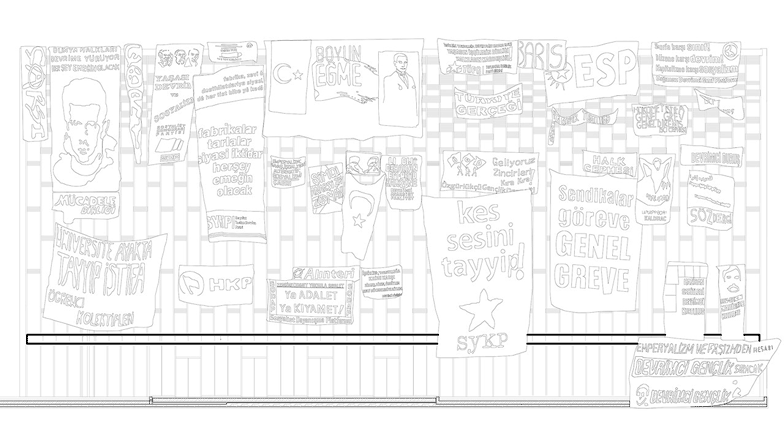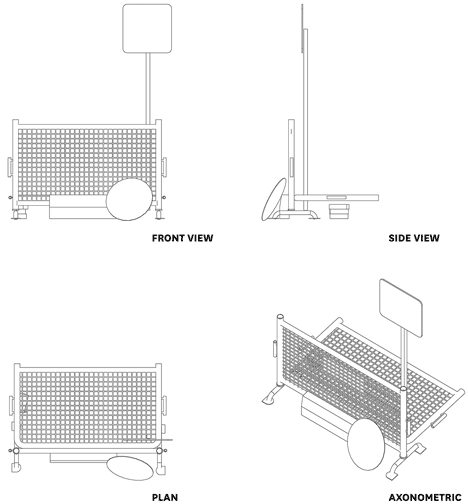Protest Art and Architecture
- Amy F. Docherty

- Nov 11, 2020
- 4 min read
Andrea Bowers
Bowers’s work addresses contemporary political concerns through its use of everyday, inexpensive materials and through slogans and questions which address the viewer directly. At the same time, she reflects on the historical precedents of current political campaigns. Bowers also celebrates a continuity of political activism that links her work to a moment in the 1890s – represented by Walter Crane – just as Crane anchored his socialist message in the folk imagery of historical rural England. By making a link to both of these historical periods, Bowers shows that while some of the causes she discusses are prompted by very contemporary crises, the rights she demands are universal and timeless.
The Worker’s Maypole, 2015
Appropriating the illustration of walter crane, the Worker’s Maypole, An Offering for May Day 1894, andrea bowers recreated the piece as a large drawing in black permanent marker pen on reclaimed sections of cardboard boxes which have been assembled to form a rectangle with irregular edges. It is part of a larger body of work that Bowers started in 2012 using the same materials, which were a reflection of the materials she saw in the occupy encampments in new york, in protest against social & economic inequality.
The Triumph of Labour, 2016
A large-scale mural that hangs dominantly in the gallery, Bowers created this monumental artwork on flattened cardboard shipping boxes, attached together and then drawing by hand over the entirety of the cardboard surface using black marker. The image drawn is another adaptation of an illustration by the British artist Walter Crane, meant to honor people who work with their hands. The style is of the same graphic quality of Crane’s woodcut image, and includes the same figures of labourers but life-size.
Laure Prouvost
Laure Prouvost was born in Justelieu (France) in 1961. Prouvost moved to London to study at Central Saint Martin’s College before completing her MA at Goldsmiths. She was the winner of the Max Mara Art Prize in 2011 and the Turner Prize in 2013 for her immersive and mixed-media installations that combine film and installation in humourous and idiosyncratic ways. Prouvost’s work addresses miscommunication and ideas becoming lost in translation. Considered by critics as both seductive and jarring, her approach to filmmaking employs layered storytelling, quick edits, montage and wordplay and is composed of a rich, tactile assortment of images, sounds, spoken and written phrases.
Ring, Sing and Drink for Trespassing, 2018
An exhibition manifesting as an escape that is both psychological and geographical, ring, sing and drink for trespassing saw The Palais de Tokyo transformed into a space where nature is purported to have taken over from humanity. Inspired by global warming, the exhibition invited visitors to explore and celebrate ambiguity by being at once intimate and expansive. Upending traditional conventions of exhibition access, a curved corridor covered in woven tapestries invites you to enter an unknown territory.
AM-BIG-YOU-US LEGSICON, 2019
AM-BIG-YOU-US LEGSICON is a cumulative exhibition which looks at the formative work and practice of Laure Prouvost throughout the start of her career. The exhibition, described as a ‘total environment emphasising the experimental, layered and intuitive aspects of the artist’s practice. Using found materials, the exhibition casts a wide panorama on the themes including the connection between the ‘modernistic binaries’ of nature and culture, intuition and rationality.
Extinction Rebellion
‘This is about what a group of people all coming together have managed to achieve. You can call it protest architecture, or architecture of activism. It’s a new typology.’
U-Build’s modules were re-designed to be simple enough that complete novices could build them, with just one shape of box and an easier bolt system. Pieces were cut at a community-run CNC workshop and supplies were bought through crowdfunding. Circles were cut into the sides of the boxes, allowing activists to lock on through them – a peaceful protest tactic where people attach themselves to shut a site down.

Extinction Rebellion’s bamboo protest towers, built under the cover of darkness by a construction team, dressed in black, were assembled in Hertfordshire within minutes from bamboo and steel cables. Each standing at three storeys high, the towers blockaded the road to the printworks of media baron Rupert Murdoch. With one protester locked onto each tower, suspended at height, extensive police efforts were unable to remove the protesters from the towers thirteen hours later. This failure led to all of Murdoch’s Saturday newspapers having to be pulped. The tensegrity towers (a portmanteau of tension and integrity) seem to hover and are comparable to experiments of Cedric price, Frei Otto, and Buckminster fuller.
Occupy Gezi
Following the occupation of Instanbul’s gezi park during one of Turkey’s largest anti-government demonstrations, non-profit herkes icin mimarlik which translates as Architecture for All created line drawings of protest shelters and structures as part of their archive. The photographs and drawings document the makeshift shelters, tents, and other temporary structures that have been constructed. Writing new definitions for ‘architecture in situations when architecture is removed from architects’ Each unique structure in Gezi Park has its own in-situ design and implementation process. Documentation of these temporary structures is of huge importance for further examination, considering their limited life-cycle.




























Comments